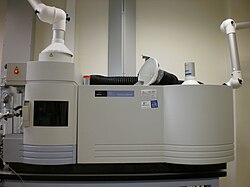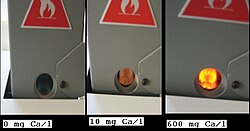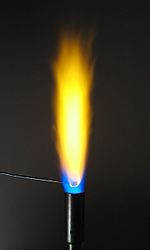Atomic emission spectroscopy

Atomic emission spectroscopy (AES) is a method of
Flame

The sample of a material (analyte) is brought into the flame as a gas, sprayed solution, or directly inserted into the flame by use of a small loop of wire, usually platinum. The heat from the flame evaporates the solvent and breaks intramolecular bonds to create free atoms. The thermal energy also excites the atoms into excited electronic states that subsequently emit light when they return to the ground electronic state. Each element emits light at a characteristic wavelength, which is dispersed by a grating or prism and detected in the spectrometer.

A frequent application of the emission measurement with the flame is the regulation of alkali metals for pharmaceutical analytics.[1]
Inductively coupled plasma

Inductively coupled plasma atomic emission spectroscopy (ICP-AES) uses an inductively coupled plasma to produce excited atoms and ions that emit electromagnetic radiation at wavelengths characteristic of a particular element.[2][3]
Advantages of ICP-AES are the excellent limit of detection and linear dynamic range, multi-element capability, low chemical interference and a stable and reproducible signal. Disadvantages are spectral interferences (many emission lines), cost and operating expense and the fact that samples typically must be in a liquid solution. Inductively coupled plasma (ICP) source of the emission consists of an induction coil and plasma. An induction coil is a coil of wire that has an alternating current flowing through it. This current induces a magnetic field inside the coil, coupling a great deal of energy to plasma contained in a quartz tube inside the coil. Plasma is a collection of charged particles (cations and electrons) capable, by virtue of their charge, of interacting with a magnetic field. The plasmas used in atomic emissions are formed by ionizing a flowing stream of argon gas. Plasma's high-temperature results from resistive heating as the charged particles move through the gas. Because plasmas operate at much higher temperatures than flames, they provide better atomization and a higher population of excited states. The predominant form of sample matrix in ICP-AES today is a liquid sample: acidified water or solids digested into aqueous forms. Liquid samples are pumped into the nebulizer and sample chamber via a peristaltic pump. Then the samples pass through a nebulizer that creates a fine mist of liquid particles. Larger water droplets condense on the sides of the spray chamber and are removed via the drain, while finer water droplets move with the argon flow and enter the plasma. With plasma emission, it is possible to analyze solid samples directly. These procedures include incorporating electrothermal vaporization, laser and spark ablation, and glow-discharge vaporization.
Spark and arc
See also
- Atomic absorption spectroscopy
- Atomic spectroscopy
- Inductively coupled plasma atomic emission spectroscopy
- Laser-induced breakdown spectroscopy
References
Bibliography
- Reynolds, R. J.; Thompson, K. C. (1978). Atomic absorption, fluorescence, and flame emission spectroscopy: a practical approach. New York: Wiley. ISBN 0-470-26478-0.
- Uden, Peter C. (1992). Element-specific chromatographic detection by atomic emission spectroscopy. Columbus, OH: ISBN 0-8412-2174-X.
External links
- "Atomic Emission Spectroscopy Tutorial". Archived from the original on 2006-05-01.
 Media related to Atomic emission spectroscopy at Wikimedia Commons
Media related to Atomic emission spectroscopy at Wikimedia Commons
